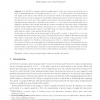44 search results - page 5 / 9 » The distinguishing number of Cartesian products of complete ... |
DM
1999
13 years 5 months ago
1999
We introduce some equivalence relations on graphs and posets and prove that they are closed under the cartesian product operation. These relations concern the edge-isoperimetric p...
SIAMDM
2008
13 years 5 months ago
2008
The power system monitoring problem asks for as few as possible measurement devices to be put in an electric power system. The problem has a graph theory model involving power dom...
JGT
2010
13 years 4 months ago
2010
Let G(V, E) be a simple, undirected graph where V is the set of vertices and E is the set of edges. A b-dimensional cube is a Cartesian product I1 × I2 × · · · × Ib, where ea...
ICCS
2009
Springer
14 years 9 days ago
2009
Springer
Abstract. In knowledge bases, the open world assumption and the ability to express variables may lead to an answer redundancy problem. This problem occurs when the returned answers...
KDD
2009
ACM
14 years 16 days ago
2009
ACM
In this paper, we consider a novel scheme referred to as Cartesian contour to concisely represent the collection of frequent itemsets. Different from the existing works, this sche...

